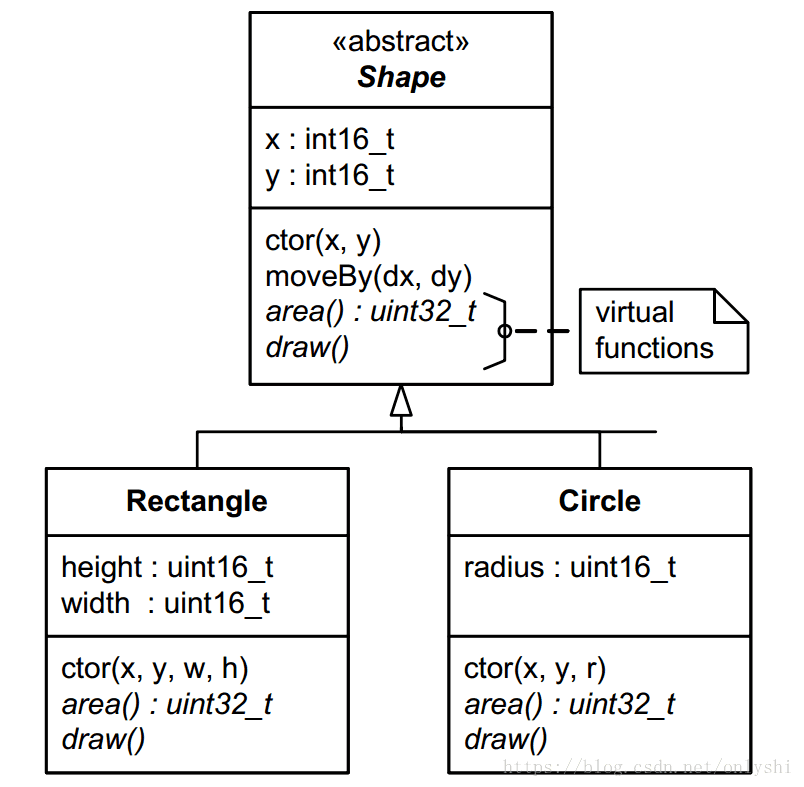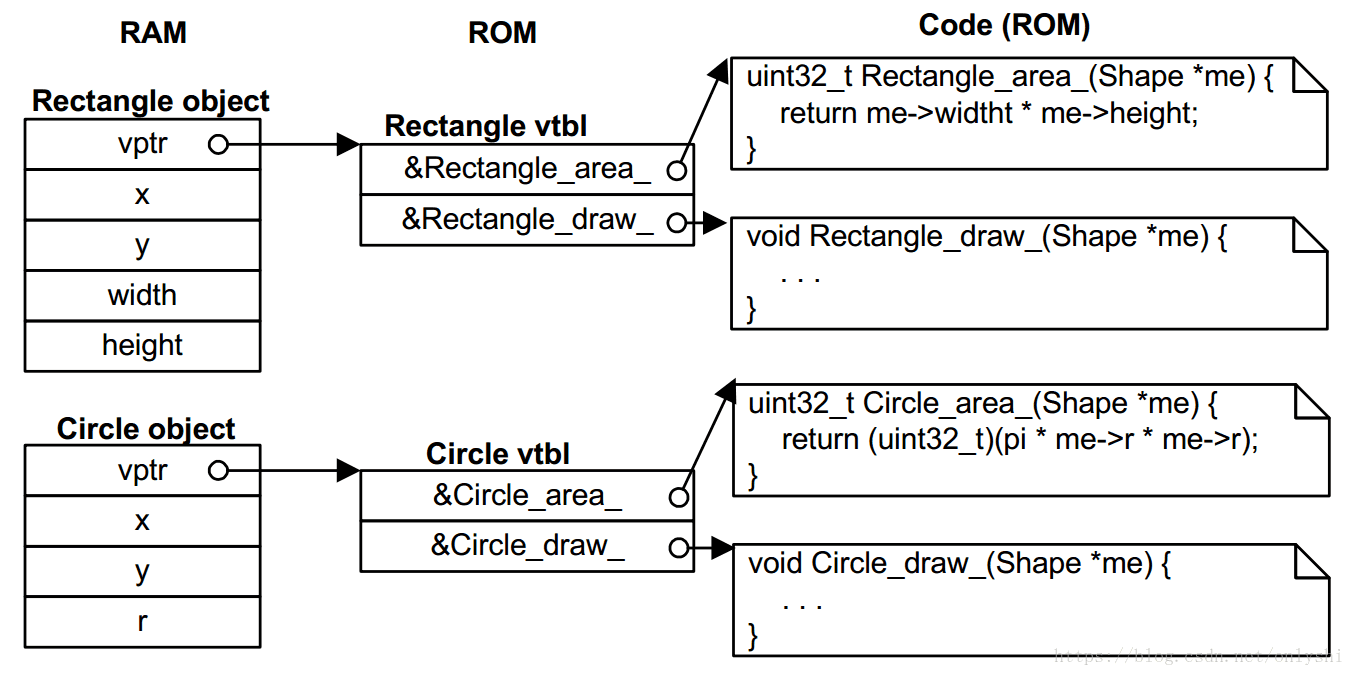C 语言实现面向对象编程
转载 https://blog.csdn.net/onlyshi/article/details/81672279
C 语言实现面向对象编程
1、引言
面向对象编程(OOP)并不是一种特定的语言或者工具,它只是一种设计方法、设计思想。它表现出来的三个最基本的特性就是封装、继承与多态。很多面向对象的编程语言已经包含这三个特性了,例如 Smalltalk、C++、Java。但是你也可以用几乎所有的编程语言来实现面向对象编程,例如 ANSI-C。要记住,面向对象是一种思想,一种方法,不要太拘泥于编程语言。
2、封装
封装就是把数据和方法打包到一个类里面。其实C语言编程者应该都已经接触过了,C 标准库
中的 fopen(), fclose(), fread(), fwrite()等函数的操作对象就是 FILE。数据内容就是 FILE,数据的读写操作就是 fread()、fwrite(),fopen() 类比于构造函数,fclose() 就是析构函数。这个看起来似乎很好理解,那下面我们实现一下基本的封装特性。
#ifndef SHAPE_H
#define SHAPE_H #include <stdint.h> // Shape 的属性
typedef struct {
int16_t x;
int16_t y;
} Shape; // Shape 的操作函数,接口函数
void Shape_ctor(Shape * const me, int16_t x, int16_t y);
void Shape_moveBy(Shape * const me, int16_t dx, int16_t dy);
int16_t Shape_getX(Shape const * const me);
int16_t Shape_getY(Shape const * const me); #endif /* SHAPE_H */
这是 Shape 类的声明,非常简单,很好理解。一般会把声明放到头文件里面 “Shape.h”。
来看下 Shape 类相关的定义,当然是在 “Shape.c” 里面。
#include "shape.h" // 构造函数
void Shape_ctor(Shape * const me, int16_t x, int16_t y)
{
me->x = x;
me->y = y;
} void Shape_moveBy(Shape * const me, int16_t dx, int16_t dy)
{
me->x += dx;
me->y += dy;
} // 获取属性值函数
int16_t Shape_getX(Shape const * const me)
{
return me->x;
}
int16_t Shape_getY(Shape const * const me)
{
return me->y;
}
再看下 main.c
#include "shape.h" /* Shape class interface */
#include <stdio.h> /* for printf() */ int main()
{
Shape s1, s2; /* multiple instances of Shape */ Shape_ctor(&s1, , );
Shape_ctor(&s2, -, ); printf("Shape s1(x=%d,y=%d)\n", Shape_getX(&s1), Shape_getY(&s1));
printf("Shape s2(x=%d,y=%d)\n", Shape_getX(&s2), Shape_getY(&s2)); Shape_moveBy(&s1, , -);
Shape_moveBy(&s2, , -); printf("Shape s1(x=%d,y=%d)\n", Shape_getX(&s1), Shape_getY(&s1));
printf("Shape s2(x=%d,y=%d)\n", Shape_getX(&s2), Shape_getY(&s2)); return ;
}
编译之后,看看执行结果:
Shape s1(x=0,y=1)
Shape s2(x=-1,y=2)
Shape s1(x=2,y=-3)
Shape s2(x=0,y=0)
整个例子,非常简单,非常好理解。以后写代码时候,要多去想想标准库的文件IO操作,这样也有意识的去培养面向对象编程的思维。
3、继承
继承就是基于现有的一个类去定义一个新类,这样有助于重用代码,更好的组织代码。在 C 语言里面,去实现单继承也非常简单,只要把基类放到继承类的第一个数据成员的位置就行了。
例如,我们现在要创建一个 Rectangle 类,我们只要继承 Shape 类已经存在的属性和操作,再添加不同于 Shape 的属性和操作到 Rectangle 中。
下面是 Rectangle 的声明与定义:
#ifndef RECT_H
#define RECT_H #include "shape.h" // 基类接口 // 矩形的属性
typedef struct {
Shape super; // 继承 Shape // 自己的属性
uint16_t width;
uint16_t height;
} Rectangle; // 构造函数
void Rectangle_ctor(Rectangle * const me, int16_t x, int16_t y,
uint16_t width, uint16_t height); #endif /* RECT_H */
#include "rect.h" // 构造函数
void Rectangle_ctor(Rectangle * const me, int16_t x, int16_t y,
uint16_t width, uint16_t height)
{
/* first call superclass’ ctor */
Shape_ctor(&me->super, x, y); /* next, you initialize the attributes added by this subclass... */
me->width = width;
me->height = height;
}
我们来看一下 Rectangle 的继承关系和内存布局

因为有这样的内存布局,所以你可以很安全的传一个指向 Rectangle 对象的指针到一个期望传入 Shape 对象的指针的函数中,就是一个函数的参数是 “Shape *”,你可以传入 “Rectangle *”,并且这是非常安全的。这样的话,基类的所有属性和方法都可以被继承类继承!
#include "rect.h"
#include <stdio.h> int main()
{
Rectangle r1, r2; // 实例化对象
Rectangle_ctor(&r1, , , , );
Rectangle_ctor(&r2, -, , , ); printf("Rect r1(x=%d,y=%d,width=%d,height=%d)\n",
Shape_getX(&r1.super), Shape_getY(&r1.super),
r1.width, r1.height);
printf("Rect r2(x=%d,y=%d,width=%d,height=%d)\n",
Shape_getX(&r2.super), Shape_getY(&r2.super),
r2.width, r2.height); // 注意,这里有两种方式,一是强转类型,二是直接使用成员地址
Shape_moveBy((Shape *)&r1, -, );
Shape_moveBy(&r2.super, , -); printf("Rect r1(x=%d,y=%d,width=%d,height=%d)\n",
Shape_getX(&r1.super), Shape_getY(&r1.super),
r1.width, r1.height);
printf("Rect r2(x=%d,y=%d,width=%d,height=%d)\n",
Shape_getX(&r2.super), Shape_getY(&r2.super),
r2.width, r2.height); return ;
}
输出结果:
Rect r1(x=0,y=2,width=10,height=15)
Rect r2(x=-1,y=3,width=5,height=8)
Rect r1(x=-2,y=5,width=10,height=15)
Rect r2(x=1,y=2,width=5,height=8)
4、多态
C++ 语言实现多态就是使用虚函数。在 C 语言里面,也可以实现多态。
现在,我们又要增加一个圆形,并且在 Shape 要扩展功能,我们要增加 area() 和 draw() 函数。但是 Shape 相当于抽象类,不知道怎么去计算自己的面积,更不知道怎么去画出来自己。而且,矩形和圆形的面积计算方式和几何图像也是不一样的。
下面让我们重新声明一下 Shape 类
#ifndef SHAPE_H
#define SHAPE_H #include <stdint.h> struct ShapeVtbl;
// Shape 的属性
typedef struct {
struct ShapeVtbl const *vptr;
int16_t x;
int16_t y;
} Shape; // Shape 的虚表
struct ShapeVtbl {
uint32_t (*area)(Shape const * const me);
void (*draw)(Shape const * const me);
}; // Shape 的操作函数,接口函数
void Shape_ctor(Shape * const me, int16_t x, int16_t y);
void Shape_moveBy(Shape * const me, int16_t dx, int16_t dy);
int16_t Shape_getX(Shape const * const me);
int16_t Shape_getY(Shape const * const me); static inline uint32_t Shape_area(Shape const * const me)
{
return (*me->vptr->area)(me);
} static inline void Shape_draw(Shape const * const me)
{
(*me->vptr->draw)(me);
} Shape const *largestShape(Shape const *shapes[], uint32_t nShapes);
void drawAllShapes(Shape const *shapes[], uint32_t nShapes); #endif /* SHAPE_H */
看下加上虚函数之后的类关系图

4.1 虚表和虚指针
虚表(Virtual Table)是这个类所有虚函数的函数指针的集合。
虚指针(Virtual Pointer)是一个指向虚表的指针。这个虚指针必须存在于每个对象实例中,会被所有子类继承。
在《Inside The C++ Object Model》的第一章内容中,有这些介绍。
4.2 在构造函数中设置vptr
在每一个对象实例中,vptr 必须被初始化指向其 vtbl。最好的初始化位置就是在类的构造函数中。事实上,在构造函数中,C++ 编译器隐式的创建了一个初始化的vptr。在 C 语言里面, 我们必须显示的初始化vptr。
下面就展示一下,在 Shape 的构造函数里面,如何去初始化这个 vptr。 #include "shape.h"
#include <assert.h> // Shape 的虚函数
static uint32_t Shape_area_(Shape const * const me);
static void Shape_draw_(Shape const * const me); // 构造函数
void Shape_ctor(Shape * const me, int16_t x, int16_t y)
{
// Shape 类的虚表
static struct ShapeVtbl const vtbl =
{
&Shape_area_,
&Shape_draw_
};
me->vptr = &vtbl;
me->x = x;
me->y = y;
} void Shape_moveBy(Shape * const me, int16_t dx, int16_t dy)
{
me->x += dx;
me->y += dy;
} int16_t Shape_getX(Shape const * const me)
{
return me->x;
}
int16_t Shape_getY(Shape const * const me)
{
return me->y;
} // Shape 类的虚函数实现
static uint32_t Shape_area_(Shape const * const me)
{
assert(); // 类似纯虚函数
return 0U; // 避免警告
} static void Shape_draw_(Shape const * const me)
{
assert(); // 纯虚函数不能被调用
} Shape const *largestShape(Shape const *shapes[], uint32_t nShapes)
{
Shape const *s = (Shape *);
uint32_t max = 0U;
uint32_t i;
for (i = 0U; i < nShapes; ++i)
{
uint32_t area = Shape_area(shapes[i]);// 虚函数调用
if (area > max)
{
max = area;
s = shapes[i];
}
}
return s;
} void drawAllShapes(Shape const *shapes[], uint32_t nShapes)
{
uint32_t i;
for (i = 0U; i < nShapes; ++i)
{
Shape_draw(shapes[i]); // 虚函数调用
}
}
注释比较清晰,这里不再多做解释。
4.3 继承 vtbl 和 重载 vptr
上面已经提到过,基类包含 vptr,子类会自动继承。但是,vptr 需要被子类的虚表重新赋值。并且,这也必须发生在子类的构造函数中。下面是 Rectangle 的构造函数。
#include "rect.h"
#include <stdio.h> // Rectangle 虚函数
static uint32_t Rectangle_area_(Shape const * const me);
static void Rectangle_draw_(Shape const * const me); // 构造函数
void Rectangle_ctor(Rectangle * const me, int16_t x, int16_t y,
uint16_t width, uint16_t height)
{
static struct ShapeVtbl const vtbl =
{
&Rectangle_area_,
&Rectangle_draw_
};
Shape_ctor(&me->super, x, y); // 调用基类的构造函数
me->super.vptr = &vtbl; // 重载 vptr
me->width = width;
me->height = height;
} // Rectangle's 虚函数实现
static uint32_t Rectangle_area_(Shape const * const me)
{
Rectangle const * const me_ = (Rectangle const *)me; //显示的转换
return (uint32_t)me_->width * (uint32_t)me_->height;
} static void Rectangle_draw_(Shape const * const me)
{
Rectangle const * const me_ = (Rectangle const *)me; //显示的转换
printf("Rectangle_draw_(x=%d,y=%d,width=%d,height=%d)\n",
Shape_getX(me), Shape_getY(me), me_->width, me_->height);
}
4.4 虚函数调用
有了前面虚表(Virtual Tables)和虚指针(Virtual Pointers)的基础实现,虚拟调用(后期绑定)就可以用下面代码实现了。
uint32_t Shape_area(Shape const * const me)
{
return (*me->vptr->area)(me);
}
这个函数可以放到.c文件里面,但是会带来一个缺点就是每个虚拟调用都有额外的调用开销。为了避免这个缺点,如果编译器支持内联函数(C99)。我们可以把定义放到头文件里面,类似下面:
static inline uint32_t Shape_area(Shape const * const me)
{
return (*me->vptr->area)(me);
}
如果是老一点的编译器(C89),我们可以用宏函数来实现,类似下面这样:
#define Shape_area(me_) ((*(me_)->vptr->area)((me_)))
1
看一下例子中的调用机制:

4.5 main.c
#include "rect.h"
#include "circle.h"
#include <stdio.h> int main()
{
Rectangle r1, r2;
Circle c1, c2;
Shape const *shapes[] =
{
&c1.super,
&r2.super,
&c2.super,
&r1.super
};
Shape const *s; // 实例化矩形对象
Rectangle_ctor(&r1, , , , );
Rectangle_ctor(&r2, -, , , ); // 实例化圆形对象
Circle_ctor(&c1, , -, );
Circle_ctor(&c2, , -, ); s = largestShape(shapes, sizeof(shapes)/sizeof(shapes[]));
printf("largetsShape s(x=%d,y=%d)\n", Shape_getX(s), Shape_getY(s)); drawAllShapes(shapes, sizeof(shapes)/sizeof(shapes[])); return ;
}
输出结果:
largetsShape s(x=1,y=-2)
Circle_draw_(x=1,y=-2,rad=12)
Rectangle_draw_(x=-1,y=3,width=5,height=8)
Circle_draw_(x=1,y=-3,rad=6)
Rectangle_draw_(x=0,y=2,width=10,height=15)
5、总结
还是那句话,面向对象编程是一种方法,并不局限于某一种编程语言。用 C 语言实现封装、单继承,理解和实现起来比较简单,多态反而会稍微复杂一点,如果打算广泛的使用多态,还是推荐转到 C++ 语言上,毕竟这层复杂性被这个语言给封装了,你只需要简单的使用就行了。但并不代表,C 语言实现不了多态这个特性。
C 语言实现面向对象编程的更多相关文章
- 基于C语言的面向对象编程
嵌入式软件开发中,虽然很多的开发工具已经支持C++的开发,但是因为有时考虑运行效率和编程习惯,还是有很多人喜欢用C来开发嵌入式软件.Miro Samek说:"我在开发现场发现,很多嵌入式软件 ...
- 一步步分析:C语言如何面向对象编程
这是道哥的第009篇原创 一.前言 在嵌入式开发中,C/C++语言是使用最普及的,在C++11版本之前,它们的语法是比较相似的,只不过C++提供了面向对象的编程方式. 虽然C++语言是从C语言发展而来 ...
- 真的可以啊,用C语言实现面向对象编程O O P!C语言真的无所不能~
解释区分一下C语言和OOP 我们经常说C语言是面向过程的,而C++是面向对象的,然而何为面向对象,什么又是面向过程呢?不管怎么样,我们最原始的目标只有一个就是实现我们所需要的功能,从这一点说它们是殊途 ...
- Python源代码 -- C语言实现面向对象编程(基类&派生类&多态)
背景 python是面向对象的解释性语言.然而python是通过C语言实现的,C语言怎么跟面向对象扯上了关系? C语言能够实现面向对象的性质? 原文链接:http://blog.csdn.net/or ...
- 真的可以,用C语言实现面向对象编程OOP
ID:技术让梦想更伟大 作者:李肖遥 解释区分一下C语言和OOP 我们经常说C语言是面向过程的,而C++是面向对象的,然而何为面向对象,什么又是面向过程呢?不管怎么样,我们最原始的目标只有一个就是实现 ...
- Objective-C语言介绍 、 Objc与C语言 、 面向对象编程 、 类和对象 、 属性和方法 、 属性和实例变量
1 第一个OC控制台程序 1.1 问题 Xcode是苹果公司向开发人员提供的集成开发环境(非开源),用于开发Mac OS X,iOS的应用程序.其运行于苹果公司的Mac操作系统下. 本案例要求使用集成 ...
- C语言进行面向对象编程
http://blog.csdn.net/dadalan/article/details/3983888 http://blog.163.com/zhqh43@126/blog/static/4043 ...
- c语言实现面向对象编程
1.通用校验器接口(validator.h) #ifndef VALIDATOR_H_INCLUDED #define VALIDATOR_H_INCLUDED #include<stdbool ...
- 云风:我所偏爱的C语言面向对象编程范式
面向对象编程不是银弹.大部分场合,我对面向对象的使用非常谨慎,能不用则不用.相关的讨论就不展开了. 但是,某些场合下,采用面向对象的确是比较好的方案.比如 UI 框架,又比如 3d 渲染引擎中的场景管 ...
随机推荐
- Windows里面的虚拟机,部署的项目在同一网段也可以访问到
一直想对自己Linux里面部署的项目进行再同一网段进行共享让其他和我同网段的人都看到 今天对于这个问题我终于解决了 首先编辑自己的虚拟机 进行虚拟机网络编辑 选择VMnet8 然后进行下面的NET设置 ...
- MySQL启动失败故障思路
1.1 查看 日志 默认路径在数据路径下,以当前主机名加上.err命名 如主机名为tz,数据路径为/mnt/mysql_data目录下 日志文件为tz.err [root@tz mysql_data] ...
- ubuntu set up 2 - 双系统时间问题
http://ubuntuhandbook.org/index.php/2016/05/time-differences-ubuntu-1604-windows-10/ For users who d ...
- Verilog-格雷码加法器
1.概述 格雷码执行加1操作最多只会变1位,可用在多位地址指针中消除毛刺. 2.verilog代码 `timescale 1ns / 1ps module gray_adder #() ( input ...
- 题解【AcWing902】最短编辑距离
题面 经典的最长公共子序列模型. 我们设 \(dp_{i,j}\) 表示 \(a_{1...i}\) 与 \(b_{1...j}\) 匹配上所需的最少操作数. 考虑删除操作,我们将 \(a_i\) 删 ...
- Qtree1 - 树链剖分
树剖裸题?(复习练练手) // luogu-judger-enable-o2 #include <bits/stdc++.h> using namespace std; ],size[], ...
- RN开发-ReactJS组件
虚拟DOM :将真实的DOM结构虚拟成json类型数据 props : 不可改变,用于数据传递 state : 组件属性,主要用来存储组件自身需要的数据,每次改变都会引起组件的更新 ...
- vue 动态组件的传值
vue项目开发中会用到大量的父子组件传值,也会用到动态组件的传值,常规子组件获取父组件的传值时,第一次是获取不到的,这时候有两种解决方案 第一种: 父组件向子组件传的是一个json对象,ES6的方法O ...
- 采用PHP实现”服务器推”技术的聊天室
传统的B/S结构的应用程序,都是采用”客户端拉”结束来实现客户端和服务器端的数据交换. 本文将通过结合Ticks(可以参看我的另外一篇文章:关于PHP你可能不知道的-PHP的事件驱动化设计),来实 ...
- java内部类概念
一.成员内部类作为外部类的成员存在的类,则称之为成员内部类 public class OuterClass{ public class InnerClass{ } } 成员内部类样例 成员内部类具有如 ...
